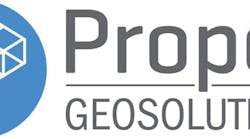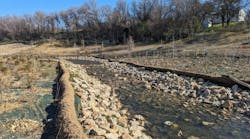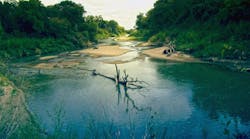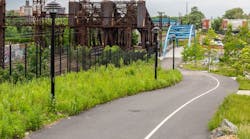Propex
www.propexglobal.com | 800.621.1273
On Oct. 27, 2000, the Energy and Water Development Appropriations Act of 2001 was signed into law, directing the U.S. Army Corps of Engineers (USACE) to proceed with a detailed engineering design for the Murrieta Creek Flood Control, Environmental Restoration and Recreation Project.
The project included major flood control improvements to more than 7 miles of channels on the Murrieta Creek between the cities of Murrieta and Temecula, Calif. Historically, this area had experienced devastating flooding, which continued to be a major threat to businesses and homes in the area. An estimated 600 homes and commercial structures, sewage treatment facilities, transportation infrastructure and the Camp Pendleton Marine Corps Base all were in jeopardy of destruction from flooding.
The two main objectives of the project were to provide flood protection to areas susceptible to 100-year floods and enhance water conservation and supply. Phase 1 included channel improvements and widening the creek using hard armoring erosion control, including reinforcing channel walls through historic Old Town Temecula. Unhappy with the stale, lifeless look of the hard armoring used during Phase 1, the design engineer wanted an erosion and scour solution for Phase 2-A that would promote a flourishing riparian habitat.
Armormax Engineered Earth Armoring System was selected because it can handle the shear stresses and velocities associated with the 100-year flood, it promotes groundwater recharge for water conservation, and it encourages vegetative growth. Additionally, the system costs significantly less. The system is composed of Pyramat 75 High- Performance Turf Reinforcement Mat (HPTRM) and Engineered Earth
Anchors (EEA) that work together to lock soil in place and provide dynamic erosion control. The HPTRM features a patented trilobal design that promotes rapid root development for long-term vegetation. This vegetating system provides environmental benefits, such as filtering storm water pollutants to improve water quality and encouraging optimal habitats for aquatic life. Conversely, hard armoring can decrease stream-side vegetation and adversely impact fish populations.
Another benefit of using the system is its small carbon footprint. Only 1 sq meter of its HPTRM has a cradle-to-grave carbon footprint of 2.7 kg carbon dioxide equivalent (CO2e), which is approximately the same as driving for 7 miles.
Approximately 4,500 sq yards of Armormax was installed along the left and right banks. Once installed, it improved water quality by decreasing sedimentation from erosion, increasing the removal of pollutants, promoting water conservation through groundwater recharge, and aiding in the creation of a natural riparian habitat. The U.S. EPA has identified erosion control systems like this that utilize HPTRMs as a best management practice for improving water quality.
Since installation, there have been several flood events to this section of Murrieta Creek, yet the bank has not experienced erosion or scour. During these flood events, large debris washed up on the protected banks, and the HPTRM remained intact and damage free. The bank is nearly 80% vegetated, delivering the natural look requested by the customer.







